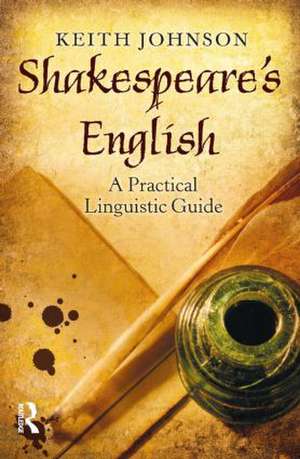Shakespeare's English: A Practical Linguistic Guide
Autor Keith Johnsonen Limba Engleză Paperback – 28 mar 2013
This book offers:
· A unique approach to the study of Early Modern English which enables students to engage independently with the topic
· Clear and engagingly written explanations of linguistic concepts
· Plentiful examples and activities, including suggestions for further work
· A glossary, further reading suggestions and guidance to relevant websites
Shakespeare's English is perfect for undergraduate students following courses that combine English language, linguistics and literature, or anyone with an interest in knowing more about the language with which Shakespeare worked his literary magic.
| Toate formatele și edițiile | Preț | Express |
|---|---|---|
| Paperback (1) | 384.58 lei 6-8 săpt. | |
| Taylor & Francis – 28 mar 2013 | 384.58 lei 6-8 săpt. | |
| Hardback (1) | 1000.27 lei 6-8 săpt. | |
| Taylor & Francis – 30 oct 2015 | 1000.27 lei 6-8 săpt. |
Preț: 384.58 lei
Nou
Puncte Express: 577
Preț estimativ în valută:
73.59€ • 76.84$ • 60.77£
73.59€ • 76.84$ • 60.77£
Carte tipărită la comandă
Livrare economică 15-29 aprilie
Preluare comenzi: 021 569.72.76
Specificații
ISBN-13: 9781408277355
ISBN-10: 1408277352
Pagini: 336
Ilustrații: illustrations
Dimensiuni: 156 x 234 x 33 mm
Greutate: 1.12 kg
Ediția:New.
Editura: Taylor & Francis
Colecția Routledge
Locul publicării:Oxford, United Kingdom
ISBN-10: 1408277352
Pagini: 336
Ilustrații: illustrations
Dimensiuni: 156 x 234 x 33 mm
Greutate: 1.12 kg
Ediția:New.
Editura: Taylor & Francis
Colecția Routledge
Locul publicării:Oxford, United Kingdom
Cuprins
Author’s acknowledgements
Publisher’s acknowledgements
Chronology of Shakespeare’s works
Phonetic symbols used
1. Why, What, and How
1.1. Shakespeare’s language? Why study it?
1.2 What is Shakespeare’s language like? An initial look
1.3 How hard is Shakespeare’s English?
1.4 Something about this book and how to use it
1.5 Shakespeare’s English? Which Shakespeare?
Whose English?
2. Inventing Words: The ‘great feast of languages’
2.1 Admiring Shakespeare’s vocabulary
2.2 The Renaissance and words
2.3 Shakespeare’s word coining
2.4 Shakespeare and the spirit of the age
3. Using Words: The fatal Cleopatras
3.1 Playing with words
3.2 ‘Kitchen diction’
3.3 ‘Never-broken chain of imagery’
3.4 Words then and now: historical false friends
3.5 Register, and other levels of variation
3.6 Fine volleys of words
4 Grammar: Inside the bonnet
4.1 Grammar and cars
4.2 Expressing grammatical information
4.3 Shakespeare as ‘half-way house’
4.4 Shakespeare: an initial look inside the bonnet
4.5 The noun phrase
4.6 The verb phrase
4.7 Towards today
5. Pragmatics: Shakespeare as a foreign language
5.1 What pragmatics is
5.2 Working out pragmatic meaning: exclamations
5.3 How to be polite in Shakespeare
5.4 A speech act: directives
5.5 Thou and you (and ye)
5.6 Implicature
5.7 The need for pragmatic awareness
6. Rhetoric: ‘Sweet and honeyed sentences’
6.1 Complicated sentences
6.2 Compound and complex sentences
6.3 The history of rhetoric in a nutshell
6.4 Some Renaissance styles
6.5 Rhetorical devices
6.6 Energy and growth
7. Verse and Prose: Iambic pentameters all the time?
7.1 Blank verse
7.2 Verse and prose
7.3 Blank, rhyme and prose: the mix
8. Shakespeare on the Page: ‘Wryting englysh treu’
8.1 Taste and fancy
8.2 Spelling
8.3 Punctuation
8.4 A look at the First Folio
8.5 Variation and standardisation
9. Sounds: The ‘tongue’s sweet melody’
9.1 How different . . . and why bother?
9.2 A first look (or listen)
9.3 Looking at some consonants
9.4 Some vowels and diphthongs
9.5 Some EModE pronunciation ‘practice drills’
9.6 Shakespearean pronunciation: how do we know?
9.7 More on puns and homophones
9.8 Stress
9.9 Pronunciation and comprehension
10. Our revels now are ended
10.1 Language points in one passage
10.2 After the revels
Glossary
References
Index
Publisher’s acknowledgements
Chronology of Shakespeare’s works
Phonetic symbols used
1. Why, What, and How
1.1. Shakespeare’s language? Why study it?
1.2 What is Shakespeare’s language like? An initial look
1.3 How hard is Shakespeare’s English?
1.4 Something about this book and how to use it
1.5 Shakespeare’s English? Which Shakespeare?
Whose English?
2. Inventing Words: The ‘great feast of languages’
2.1 Admiring Shakespeare’s vocabulary
2.2 The Renaissance and words
2.3 Shakespeare’s word coining
2.4 Shakespeare and the spirit of the age
3. Using Words: The fatal Cleopatras
3.1 Playing with words
3.2 ‘Kitchen diction’
3.3 ‘Never-broken chain of imagery’
3.4 Words then and now: historical false friends
3.5 Register, and other levels of variation
3.6 Fine volleys of words
4 Grammar: Inside the bonnet
4.1 Grammar and cars
4.2 Expressing grammatical information
4.3 Shakespeare as ‘half-way house’
4.4 Shakespeare: an initial look inside the bonnet
4.5 The noun phrase
4.6 The verb phrase
4.7 Towards today
5. Pragmatics: Shakespeare as a foreign language
5.1 What pragmatics is
5.2 Working out pragmatic meaning: exclamations
5.3 How to be polite in Shakespeare
5.4 A speech act: directives
5.5 Thou and you (and ye)
5.6 Implicature
5.7 The need for pragmatic awareness
6. Rhetoric: ‘Sweet and honeyed sentences’
6.1 Complicated sentences
6.2 Compound and complex sentences
6.3 The history of rhetoric in a nutshell
6.4 Some Renaissance styles
6.5 Rhetorical devices
6.6 Energy and growth
7. Verse and Prose: Iambic pentameters all the time?
7.1 Blank verse
7.2 Verse and prose
7.3 Blank, rhyme and prose: the mix
8. Shakespeare on the Page: ‘Wryting englysh treu’
8.1 Taste and fancy
8.2 Spelling
8.3 Punctuation
8.4 A look at the First Folio
8.5 Variation and standardisation
9. Sounds: The ‘tongue’s sweet melody’
9.1 How different . . . and why bother?
9.2 A first look (or listen)
9.3 Looking at some consonants
9.4 Some vowels and diphthongs
9.5 Some EModE pronunciation ‘practice drills’
9.6 Shakespearean pronunciation: how do we know?
9.7 More on puns and homophones
9.8 Stress
9.9 Pronunciation and comprehension
10. Our revels now are ended
10.1 Language points in one passage
10.2 After the revels
Glossary
References
Index
Recenzii
'With its masterly blend of general perspective, detailed illustration, and practical activity, this book takes Shakespearean languages studies to a new level.'
Professor David Crystal, author of 'Think On My Words: Exploring Shakespeare's Language
"A fascinating and practical guide to the uses and development of the English language in Shakespeare's work... It is a detailed, light-hearted, informative and wholly comprehensive guide to the pleasures and vicissitudes of Shakespeare's – and our – English."
Charlotte Scott, Goldsmiths, University of London, UK, in Shakespeare Survey 68 (2015)
Professor David Crystal, author of 'Think On My Words: Exploring Shakespeare's Language
"A fascinating and practical guide to the uses and development of the English language in Shakespeare's work... It is a detailed, light-hearted, informative and wholly comprehensive guide to the pleasures and vicissitudes of Shakespeare's – and our – English."
Charlotte Scott, Goldsmiths, University of London, UK, in Shakespeare Survey 68 (2015)
Descriere
Shakespeare’s English: A Practical Linguistic Guide provides students with a solid grounding for understanding the language of Shakespeare and its place within the development of English. With a prime focus on Shakespeare and his works, Keith Johnson covers all aspects of his language (vocabulary, grammar, sounds, rhetorical structure etc.), and gives illuminating background information on the linguistic context of the Elizabethan Age. As well as providing a unique introduction to the subject, Johnson encourages a ‘hands-on’ approach, guiding students, through the use of activities, towards an understanding of how Shakespeare’s English works












